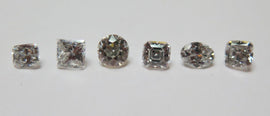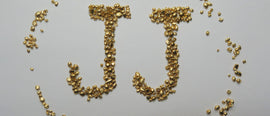Did you know about one third of diamonds have fluorescence? It is an occurrence that was once believed to be a faulty characteristic. Today it’s a more acceptable, and beneficial trait when teamed up with the right attributes. The Gemological Institute of America defines fluorescence as emission of visible light by a material when it is exposed to ultraviolet radiation. Therefore, ultraviolet lighting (UV), including sunlight, will bring out the fluorescence. Diamonds with this intriguing occurrence will emit a faint to strong glow, commonly blue in color, but can fluoresce in almost any color.
 Why does fluorescence occur in some diamonds, but not all? Most people know diamonds are composed of one element, Carbon. When another trace element is present in the diamond crystal’s lattice-like structure, its atoms will interact with the carbon atoms. This interaction caused by UV light, stimulates the energy of the atoms, resulting in the occurrence of fluorescence.
Why does fluorescence occur in some diamonds, but not all? Most people know diamonds are composed of one element, Carbon. When another trace element is present in the diamond crystal’s lattice-like structure, its atoms will interact with the carbon atoms. This interaction caused by UV light, stimulates the energy of the atoms, resulting in the occurrence of fluorescence.
To break it down further, and hopefully a bit more simply, one single Carbon atom has four outer electrons and four vacant spaces to share with other electrons. When there is no fluorescence in a diamond, there are a total of eight electrons, four from the original atom, and another four shared by the neighboring carbon atom. When fluorescence is present due to a trace element, the four electrons from the trace element will mingle with the other four carbon electrons. The energy that is created by the electrons of the two different elements, carbon and most commonly nitrogen, will create the fluorescence.
It’s important to note that a fluorescence characteristic does not weaken a diamond. The atomic structural consistency remains resilient.
Can you visibly see fluorescence in a diamond? Not usually. Fluorescence is noted as having None, Faint, Medium, Strong and Very Strong by a diamond grading lab. An experienced observer may notice a diamond with fluorescence if it receives a Medium to Very Strong fluorescence description. A diamond with a very strong fluorescence may appear milky-white or have an oily look.
Will fluorescence interfere with a diamond’s sparkle? No. The diamond’s sparkle, or fire, is all stemmed from the cut and proportions of the stone itself. The better the cut grade, the more sparkle it will hold. The cut of the stones facets and their proportions are essential in creating scintillation, or the sparkle diamond is known for.
Does having a diamond with fluorescence determine a natural diamond from a diamond synthetic? No. Natural diamonds and manmade can both fluoresce.
Some pros and cons of diamonds that fluoresce are listed below:
PROS:
- Fluorescence is noted as a description characteristic of a graded diamond, not a grade.
- Consider this as an added unique feature to the diamond, like an inclusion, it’s what makes a diamond extraordinary.
- Fluorescence can influence a diamond’s color. For example, a diamond that is tinted with yellow in the I-to-N range, AND contains a moderate to strong blue fluorescence, the blue cancels out some of the yellow giving the diamond a “more colorless” appearance. This is when diamonds containing fluorescence can be an attribute.
- If many diamond melee are set in one piece, such as pave setting, using stones with some fluorescence can be set in a pattern of meaning, like initials or hidden messages.
CON:
- If a strong to very strong fluorescence is present, the face up appearance may have a milky look in diamonds that are graded colorless to near colorless or D through G. This would be considered a detriment to the stone.
- The fluorescence should be disclosed in larger diamond purchases. You wouldn’t want the wearer of the stone to be surprised by a strange glow at a night club or other venue with black lights.
If you’re in the market for a diamond, you will know a bit more about fluorescence. Fluorescence can be found in antique to modern cut diamonds, melee to large diamonds of any shape. A big take-away, as the buyer, is to know whether or not the diamond you are purchasing contains fluorescence or not. A quality diamond dealer should disclose the characteristic.
Kerry-Ann Jobin
Graduate of Diamonds, GIA
Resources of information:
Gemological Institute of America
Gems and Gemology articles



